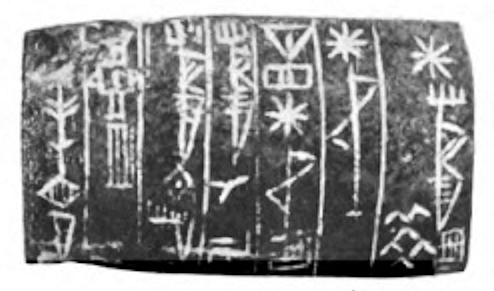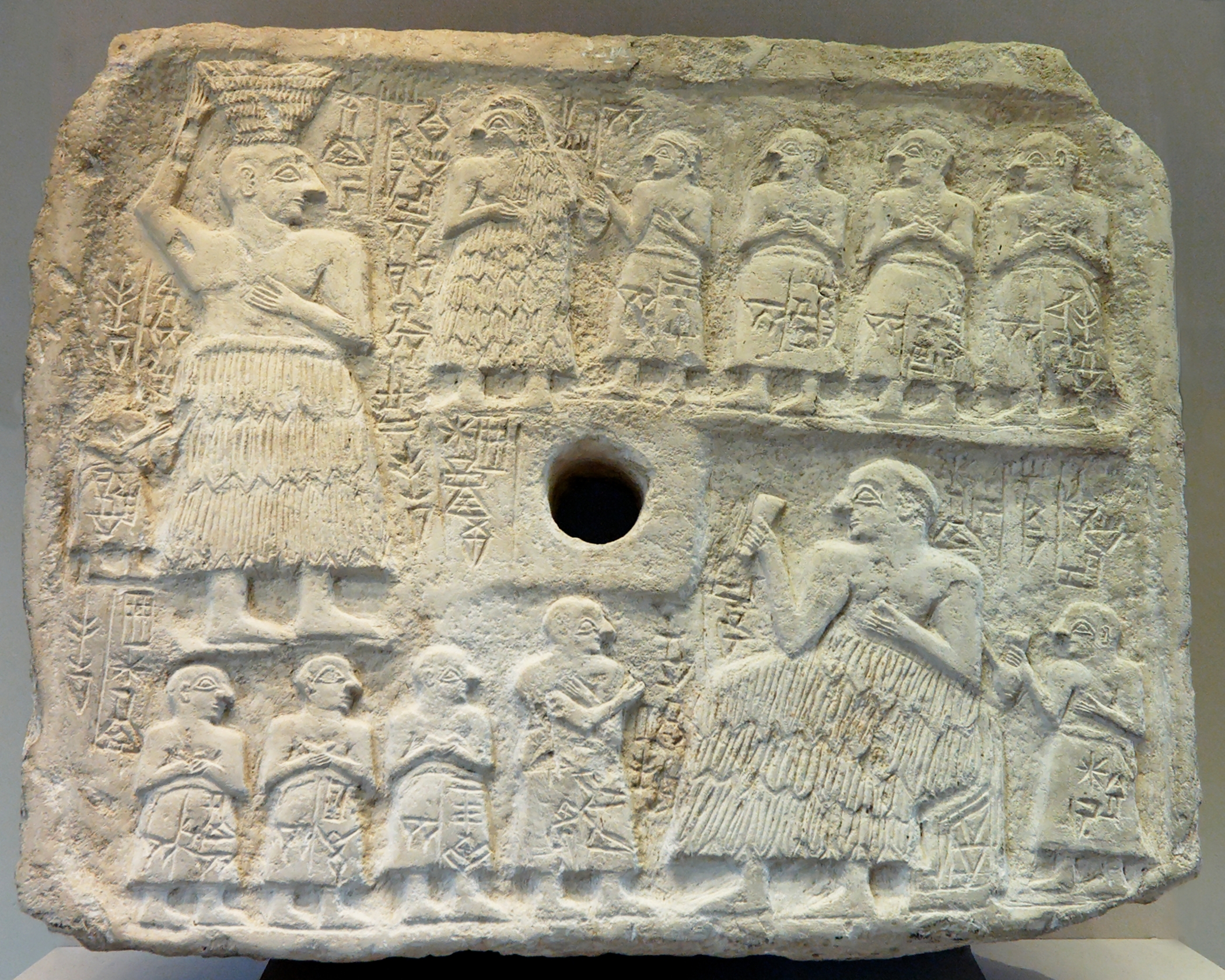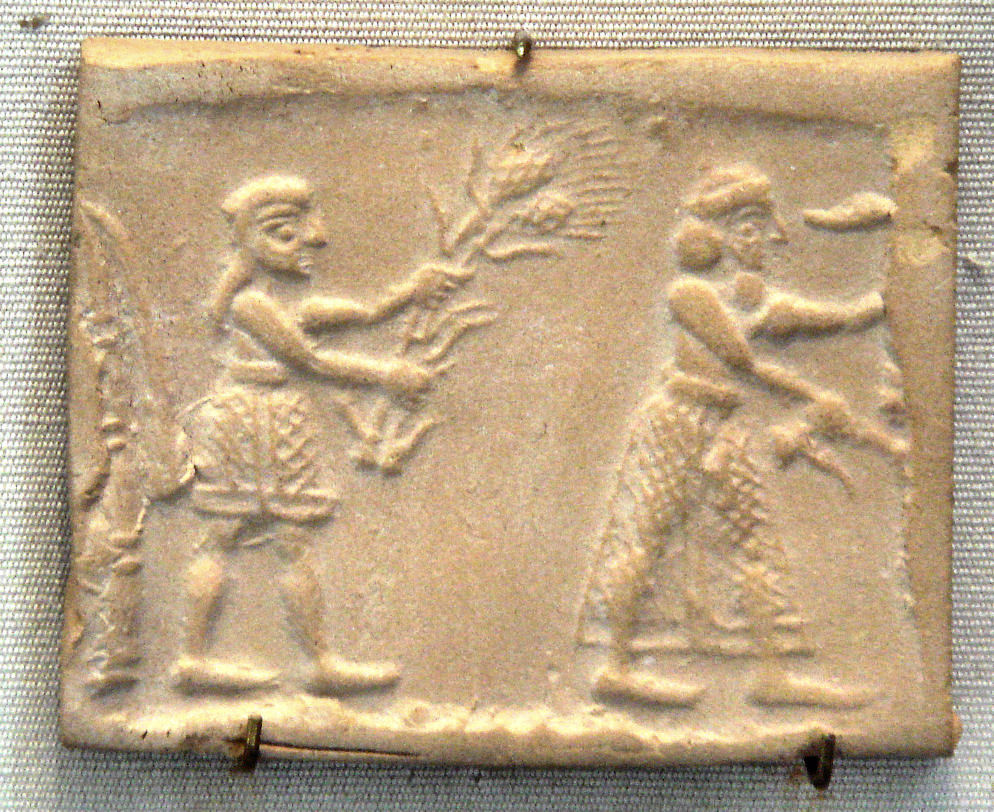|
Lugal-kinishe-dudu
Lugal-kinishe-dudu (, ''lugal-ki-ni-še₃-du₇-du₇'') also Lugal-kiginne-dudu (, ''lugal-ki-gin-ne2-du₇-du₇''), was a King and ( ensi) of Uruk and Ur who lived towards the end of the 25th century BCE. The Sumerian King List mentions Lugal-kinishe-dudu as the second king of the dynasty after En-cakanca-ana, attributing to him a fanciful reign of 120 years. The inscriptions of this sovereign which have been discovered show that he retained the power inherited from his predecessor, since he proclaimed himself king of Ur and Kish: Numerous fragments are known that bear the name of Lugalkinishedudu, mainly found in Nippur, and now located in the University of Pennsylvania Museum of Archaeology and Anthropology. The most remarkable document in which he is mentioned is a clay nail found in Girsu and commemorating the alliance which he concluded with Entemena of Lagash, the oldest known reference to a peace treaty between two kings: [...More Info...] [...Related Items...] OR: [Wikipedia] [Google] [Baidu] |
Enmetena
Entemena, also called Enmetena ( sux, , ), lived circa 2400 BC, was a son of En-anna-tum I, and he reestablished Lagash as a power in Sumer. He defeated Il, king of Umma, in a territorial conflict, through an alliance with Lugal-kinishe-dudu of Uruk, successor to Enshakushanna, who is in the king list. The tutelary deity Shul-utula was his personal deity. According to Jones (2012), his rule lasted 29 years. Territory Entemena of Lagash controlled the cities of southern Mesopotamia, from Badtibira to Uruk: Alliance treaty The most remarkable document in which he is mentioned is a clay nail found in Girsu and commemorating the alliance which he concluded with Lugal-kinishe-dudu of Uruk, the oldest mention of a peace treaty between two kings that we know: Deena Ragavan, Cuneiform Texts and Fragments in the Harvard Art Museum / Arthur M ... [...More Info...] [...Related Items...] OR: [Wikipedia] [Google] [Baidu] |
Entemena
Entemena, also called Enmetena ( sux, , ), lived circa 2400 BC, was a son of En-anna-tum I, and he reestablished Lagash as a power in Sumer. He defeated Il, king of Umma, in a territorial conflict, through an alliance with Lugal-kinishe-dudu of Uruk, successor to Enshakushanna, who is in the king list. The tutelary deity Shul-utula was his personal deity. According to Jones (2012), his rule lasted 29 years. Territory Entemena of Lagash controlled the cities of southern Mesopotamia, from Badtibira to Uruk: Alliance treaty The most remarkable document in which he is mentioned is a clay nail found in Girsu and commemorating the alliance which he concluded with Lugal-kinishe-dudu of Uruk, the oldest mention of a peace treaty between two kings that we know: Deena Ragavan, Cuneiform Texts and Fragments in the Harvard Art Museum / Arthur M ... [...More Info...] [...Related Items...] OR: [Wikipedia] [Google] [Baidu] |
Lugal-kisal-si
Lugal-kisalsi, also Lugaltarsi (, ''lugal-kisal-si'', also , ''lugal-tar-si'', ''lugal-sila-si'') was a King of Uruk and Ur who lived towards the end of the 25th century BCE, succeeding his father Lugal-kinishe-dudu, according to contemporary inscriptions, although he does not appear in the Sumerian King List (but his father does in some versions). In one of his inscriptions, he appears as "Lugalkisalsi, the first-born son of Lugalkigenedudu, king of Uruk and Ur". He had a son named Lubarasi, and a grandson named Silim-Utu. Numerous inscriptions in his name are known. Inscriptions Lugal-kisalsi is known from several inscriptions. Lugal-kisalsi was also called "King of Kish" in some of his inscriptions: File:Lugal-kisal-si fragment.jpg, A vase fragment with the name "Lugal-kisal-(si)": ''en-lil / lugal kur-kur-ra / lugal-kisal-si / umusag#'' () "For Enlil, king of all the lands, by Lugalkisalsi, the first-born son f Lugalkigenedudu, king of Uruk and Ur">Lugalkigenedudu.html" ... [...More Info...] [...Related Items...] OR: [Wikipedia] [Google] [Baidu] |
History Of Sumer
The history of Sumer spans the 5th to 3rd millennia BCE in southern Mesopotamia, and is taken to include the prehistoric Ubaid and Uruk periods. Sumer was the region's earliest known civilization and ended with the downfall of the Third Dynasty of Ur around 2004 BCE. It was followed by a transitional period of Amorite states before the rise of Babylonia in the 18th century BCE. The oldest known settlement in southern Mesopotamia is Tell el-'Oueili. The Sumerians claimed that their civilization had been brought, fully formed, to the city of Eridu by their god Enki or by his advisor (or Abgallu from ''ab''=water, ''gal''=big, ''lu''=man), Adapa U-an (the Oannes of Berossus). The first people at Eridu brought with them the Samarra culture from northern Mesopotamia and are identified with the Ubaid period, but it is not known whether or not these were Sumerians (associated later with the Uruk period). Timeline ImageSize = width:800 height:75 PlotArea = left:25 right:15 bottom ... [...More Info...] [...Related Items...] OR: [Wikipedia] [Google] [Baidu] |
Lugal-kisalsi
Lugal-kisalsi, also Lugaltarsi (, ''lugal-kisal-si'', also , ''lugal-tar-si'', ''lugal-sila-si'') was a King of Uruk and Ur who lived towards the end of the 25th century BCE, succeeding his father Lugal-kinishe-dudu, according to contemporary inscriptions, although he does not appear in the Sumerian King List (but his father does in some versions). In one of his inscriptions, he appears as "Lugalkisalsi, the first-born son of Lugalkigenedudu, king of Uruk and Ur". He had a son named Lubarasi, and a grandson named Silim-Utu. Numerous inscriptions in his name are known. Inscriptions Lugal-kisalsi is known from several inscriptions. Lugal-kisalsi was also called "King of Kish" in some of his inscriptions: File:Lugal-kisal-si fragment.jpg, A vase fragment with the name "Lugal-kisal-(si)": ''en-lil / lugal kur-kur-ra / lugal-kisal-si / umusag#'' () "For Enlil, king of all the lands, by Lugalkisalsi, the first-born son f Lugalkigenedudu, king of Uruk and Ur">Lugalkigenedudu.html" ... [...More Info...] [...Related Items...] OR: [Wikipedia] [Google] [Baidu] |
Lagash
Lagash (cuneiform: LAGAŠKI; Sumerian: ''Lagaš''), was an ancient city state located northwest of the junction of the Euphrates and Tigris rivers and east of Uruk, about east of the modern town of Ash Shatrah, Iraq. Lagash (modern Al-Hiba) was one of the oldest cities of the Ancient Near East. The ancient site of Nina (Tell Zurghul) is around away and marks the southern limit of the state. Nearby Girsu (modern Telloh), about northwest of Lagash, was the religious center of the Lagash state. Lagash's main temple was the E-ninnu, dedicated to the god Ningirsu. Lagash seems to have incorporated the ancient cities of Girsu, Nina, Uruazagga and Erim. History From inscriptions found at Girsu such as the Gudea cylinders, it appears that Lagash was an important Sumerian city in the late 3rd millennium BC. It was at that time ruled by independent kings, Ur-Nanshe (24th century BC) and his successors, who were engaged in contests with the Elamites to the east and the kings of '' ... [...More Info...] [...Related Items...] OR: [Wikipedia] [Google] [Baidu] |
Lagaš
Lagash (cuneiform: LAGAŠKI; Sumerian language, Sumerian: ''Lagaš''), was an ancient city state located northwest of the junction of the Euphrates and Tigris rivers and east of Uruk, about east of the modern town of Ash Shatrah, Iraq. Lagash (modern Al-Hiba) was one of the oldest cities of the Ancient Near East. The ancient site of Nina (Tell Zurghul) is around away and marks the southern limit of the state. Nearby Girsu (modern Telloh), about northwest of Lagash, was the religious center of the Lagash state. Lagash's main temple was the E-ninnu, dedicated to the god Ningirsu. Lagash seems to have incorporated the ancient cities of Girsu, Nina, Uruazagga and Erim. History From inscriptions found at Girsu such as the Gudea cylinders, it appears that Lagash was an important Sumerian city in the late 3rd millennium BC. It was at that time ruled by independent kings, Ur-Nanshe (24th century BC) and his successors, who were engaged in contests with the Elamites to the east and ... [...More Info...] [...Related Items...] OR: [Wikipedia] [Google] [Baidu] |
Sumerian King List
The ''Sumerian King List'' (abbreviated ''SKL'') or ''Chronicle of the One Monarchy'' is an ancient literary composition written in Sumerian that was likely created and redacted to legitimize the claims to power of various city-states and kingdoms in southern Mesopotamia during the late third and early second millennium BC. It does so by repetitively listing Sumerian cities, the kings that ruled there, and the lengths of their reigns. Especially in the early part of the list, these reigns often span thousands of years. In the oldest known version, dated to the Ur III period (c. 2112–2004 BC) but probably based on Akkadian source material, the ''SKL'' reflected a more linear transition of power from Kish, the first city to receive kingship, to Akkad. In later versions from the Old Babylonian period, the list consisted of a large number of cities between which kingship was transferred, reflecting a more cyclical view of how kingship came to a city, only to be inevitably replace ... [...More Info...] [...Related Items...] OR: [Wikipedia] [Google] [Baidu] |
Sumerian King List
The ''Sumerian King List'' (abbreviated ''SKL'') or ''Chronicle of the One Monarchy'' is an ancient literary composition written in Sumerian that was likely created and redacted to legitimize the claims to power of various city-states and kingdoms in southern Mesopotamia during the late third and early second millennium BC. It does so by repetitively listing Sumerian cities, the kings that ruled there, and the lengths of their reigns. Especially in the early part of the list, these reigns often span thousands of years. In the oldest known version, dated to the Ur III period (c. 2112–2004 BC) but probably based on Akkadian source material, the ''SKL'' reflected a more linear transition of power from Kish, the first city to receive kingship, to Akkad. In later versions from the Old Babylonian period, the list consisted of a large number of cities between which kingship was transferred, reflecting a more cyclical view of how kingship came to a city, only to be inevitably replace ... [...More Info...] [...Related Items...] OR: [Wikipedia] [Google] [Baidu] |
Uruk
Uruk, also known as Warka or Warkah, was an ancient city of Sumer (and later of Babylonia) situated east of the present bed of the Euphrates River on the dried-up ancient channel of the Euphrates east of modern Samawah, Al-Muthannā, Iraq.Harmansah, 2007 Uruk is the type site for the Uruk period. Uruk played a leading role in the early urbanization of Sumer in the mid-4th millennium BC. By the final phase of the Uruk period around 3100 BC, the city may have had 40,000 residents, with 80,000-90,000 people living in its environs, making it the largest urban area in the world at the time. The legendary king Gilgamesh, according to the chronology presented in the ''Sumerian King List'' (henceforth ''SKL''), ruled Uruk in the 27th century BC. The city lost its prime importance around 2000 BC in the context of the struggle of Babylonia against Elam, but it remained inhabited throughout the Seleucid (312–63 BC) and Parthian (227 BC to 224 AD) periods until it was finally aband ... [...More Info...] [...Related Items...] OR: [Wikipedia] [Google] [Baidu] |
Ensi (Sumerian)
Ensi (cuneiform: , "lord of the plowland"; Emesal dialect: ''umunsik''; akk, iššakkum, script=Latn, italic=yes) was a Sumerian title designating the ruler or prince of a city-state. Originally it may have designated an independent ruler, but in later periods the title presupposed subordinance to a lugal. For the Early Dynastic Period (about 2800–2350 BC), the meaning of the titles en, ensi and lugal cannot be differentiated clearly: see lugal, ensi and en for details. Ensi may have originally been a designation of the ruler restricted to Lagash and Umma. The ''ensi'' was considered a representative of the city-state's patron deity. In later periods, an ensi was normally seen as subordinate to a lugal. Nevertheless, even the powerful rulers of the Second Dynasty of Lagash (c. 2100 BC) such as Gudea were satisfied with the title ensi. During the Third Dynasty of Ur (about 2100–2000 BC) ensi referred to the provincial governors of the kingdom. These exercised great pow ... [...More Info...] [...Related Items...] OR: [Wikipedia] [Google] [Baidu] |
Iraq
Iraq,; ku, عێراق, translit=Êraq officially the Republic of Iraq, '; ku, کۆماری عێراق, translit=Komarî Êraq is a country in Western Asia. It is bordered by Turkey to Iraq–Turkey border, the north, Iran to Iran–Iraq border, the east, the Persian Gulf and Kuwait to the southeast, Saudi Arabia to the south, Jordan to Iraq–Jordan border, the southwest and Syria to Iraq–Syria border, the west. The Capital city, capital and largest city is Baghdad. Iraq is home to diverse ethnic groups including Iraqi Arabs, Kurds, Iraqi Turkmen, Turkmens, Assyrian people, Assyrians, Armenians in Iraq, Armenians, Yazidis, Mandaeans, Iranians in Iraq, Persians and Shabaks, Shabakis with similarly diverse Geography of Iraq, geography and Wildlife of Iraq, wildlife. The vast majority of the country's 44 million residents are Muslims – the notable other faiths are Christianity in Iraq, Christianity, Yazidism, Mandaeism, Yarsanism and Zoroastrianism. The official langu ... [...More Info...] [...Related Items...] OR: [Wikipedia] [Google] [Baidu] |







.jpg)
